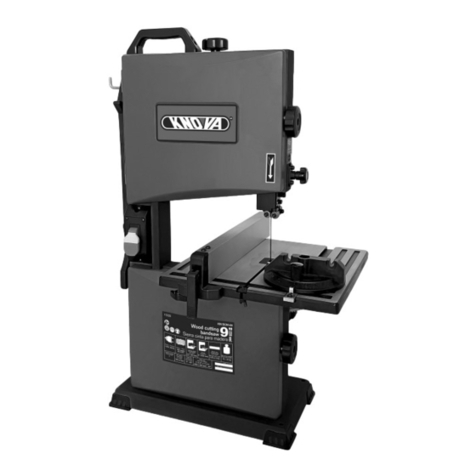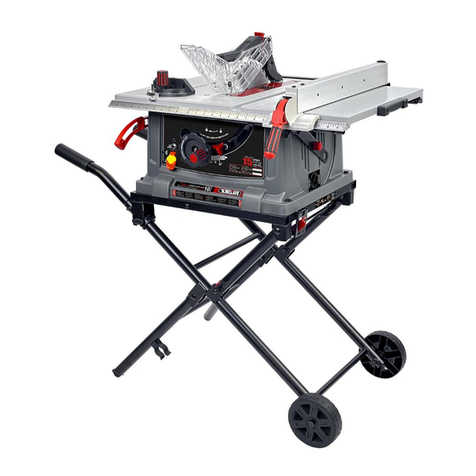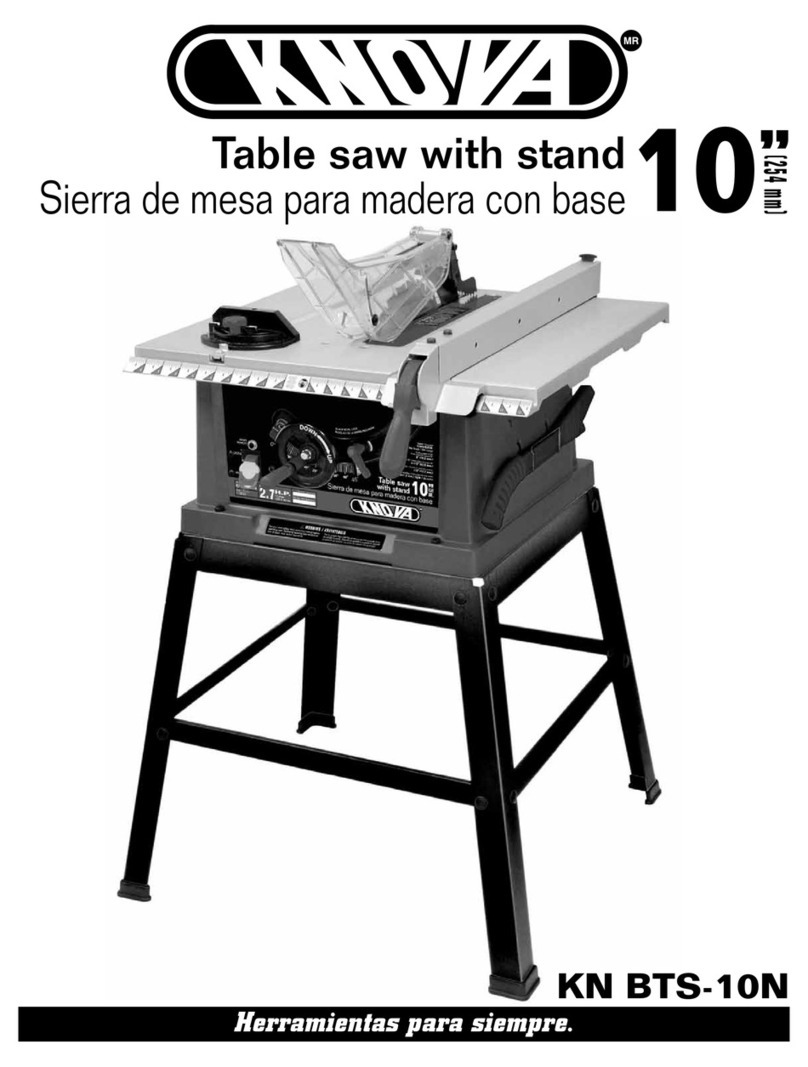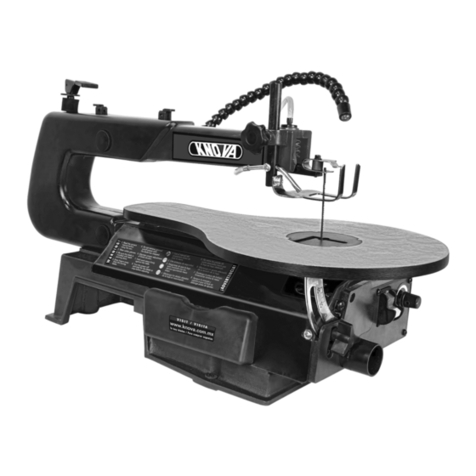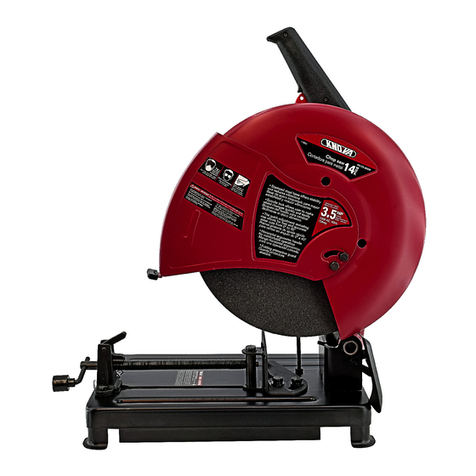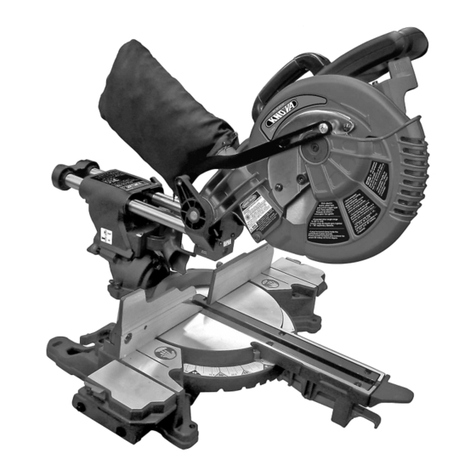
17. NEVER reach around the saw blade.
18. MAKE SURE the blade is not contacting the workpiece be-
fore the switch is turned ON.
19. IMPORTANT: After completing the cut, release the trigger
and wait for the blade to stop before returning the saw to the
raised position.
20. MAKE SURE the blade has come to a complete stop before
removing or securing the workpiece, changing the workpiece
angle or changing the angle of the blade.
21. NEVER cut metals or masonry products with this tool. This
miter saw is designed for use on wood and wood-like products.
22. NEVER cut small pieces. If the workpiece being cut would
cause your hand or fingers to be within 6-3/4 in. of the saw blade
the workpiece is too small.
23. PROVIDE adequate support to the sides of the saw table for
long work pieces.
24. NEVER use the miter saw in an area with flammable liquids
or gases.
25. NEVER use solvents to clean plastic parts. Solvents could
possibly dissolve or otherwise damage the material.
26. SHUT OFF the power before servicing or adjusting the tool.
27. DISCONNECT the saw from the power source and clean the
machine when finished using.
28. MAKE SURE the work area is clean before leaving the ma-
chine.
29. SHOULD any part of your miter saw be missing, damaged, or
fail in any way, or any electrical component fail to perform prop-
erly, lock the switch and remove the plug from the power supply
outlet. Replace missing, damaged, or failed parts before resum-
ing operation.21. DO NOT perform lay out assembly or set up
work on the table while the drill press is in operation.
ELECTRICAL REQUIREMENTS AND SAFETY
3
COMPOUND MITER SAW SAFETY
ELECTRICAL REQUIREMENTS – cont’d
DOUBLE INSULATED
The power tool is double insulated to provide a double thick-
ness of insulation between you and tool’s electrical system. All
exposed metal parts are isolated from the internal metal motor
components with protecting insulation.
Replacement parts – When servicing, use only identical re-
placement parts.
Polarized plugs – This saw has a plug that looks like the one
shown below:
To reduce the risk of electrical shock, this saw has a polarized
plug (one blade is wider than the other). This plug will fit in a
polarized outlet only one way. If the plug does not fit fully in the
outlet, reverse the plug. If it still does not fit, contact a qualified
electrician to install the proper outlet. Do not change the plug
in any way.
Double insulation does not take the place of normal safety pre-
cautions when operating this tool. To avoid electrocution:
1. Use only identical replacement parts when servicing a tool
with double insulation. Servicing should be performed by a
qualified technician.
2. Do not use power tools in wet or damp locations or expose
them to rain or snow.
MOTOR SAFETY PROTECTION IMPORTANT
To avoid motor damage, the motor should be blown out or vacu-
umed frequently to keep sawdust from interfering with the mo-
tor ventilation.
1. Connect this saw to a 120 V circuit. This circuit must not be
less than a #12 wire with a 20 A time lag fuse or a #14 wire
with a 15 A time lag fuse.
NOTE: When using an extension cord on a circuit with a
#14 wire, the extension cord must not exceed 25 feet in
length.
2. If the motor will not start, release the trigger switch
immediately. UNPLUG THE SAW. Check the saw blade to
make sure it turns freely. If the blade is free, try to start the
saw again. If the motor still does not start, refer to the
TROUBLESHOOTING GUIDE.
3. If the tool suddenly stalls while cutting wood, release the
trigger switch, unplug the tool and free the blade from the
wood. The saw may now be started and the cut finished.
4. FUSES may “blow” or circuit breakers may trip frequently if:
a. MOTOR is overloaded – overloading can occur if you
feed too rapidly or make too many start/stops in a short
time.
b. LINE VOLTAGE is more than 10% above or below the
nameplate voltage rating. For heavy loads, the voltage at
motor terminals must equal the voltage specified on the
nameplate.
c. IMPROPER or dull saw blades are used.
5. Most motor troubles may be traced to loose or incorrect
connections, overload, low voltage or inadequate power
supply wiring. Always check the connections, the load and
supply circuit if the motor doesn’t run well. Check minimum
gauge for the length of cord you are using on the chart
below.
GUIDELINES FOR EXTENSION CORDS
Use a proper extension cord. Make sure your extension cord
is in good condition. When using an extension cord, be sure
to use one heavy enough to carry the current your product
will draw. An undersized cord will cause a drop in line volt-
age, resulting in loss of power and overheating. The table be-
low shows the correct size to use depending on cord length
and nameplate ampere rating. If in doubt, use the next heavier
gauge. The smaller the gauge number, the heavier the cord.
WARNING




